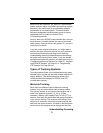
25
Understanding Scanning
talk group will switch to the correct channel. To program
an EDACS system in your scanner, you will need to know
both the frequencies used by the system and the LCN for
each frequency.
Agency-Fleet-Subfleet – talk group ID’s for EDACS sys-
tems are assigned in a way that makes it easy to see at a
glance the affiliation of the user. Each radio is assigned a
2-digit agency identifier from 00 – 15. For example, 01
might be used by the police, 02 by ambulance service, 03
by the fire department, and so on. Each agency is then
subdivided up to 16 times to provide fleet identification,
and then 8 more times to identify subfleets.
For example, the complete AFS for the Police Depart-
ment West District’s dispatch channel might be 01-062.
01 identifies the agency as the police department, 06
identifies the fleet as the West district, and 2 identifies the
subfleet as the dispatch channel. While these assign-
ments are somewhat arbitrary and vary from system to
system, there are many resources on the web for finding
the assignments for most systems. Because of the logical
hierarchy of the AFS system, your BC246T lets you
assign wildcard ID’s that let you, for example, use only
one ID memory to identify all units in either an agency or
a fleet.
EDACS SCAT – EDACS SCAT (Single Channel
Autonomous Trunking) systems operate on a single
channel and alternate control data with analog voice traf-
fic. While your BC246T cannot track ID’s in this system,
it can eliminate the control data so that all you hear is the
voice transmissions when you monitor this type of
system.
LTR Trunking
LTR (Logic Trunked Radio) systems are trunking systems
used primarily by business or private communications
service providers, such as taxicabs, delivery trucks, and
repair services. These systems encode all control infor-
mation as digital subaudible data that accompanies each
transmission, so there is no separate control channel.


















